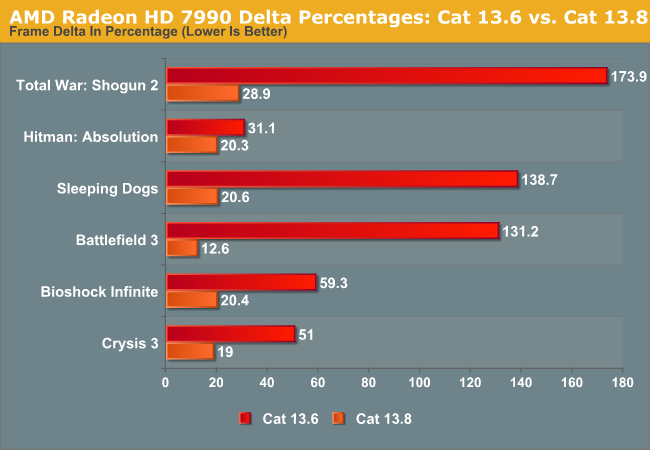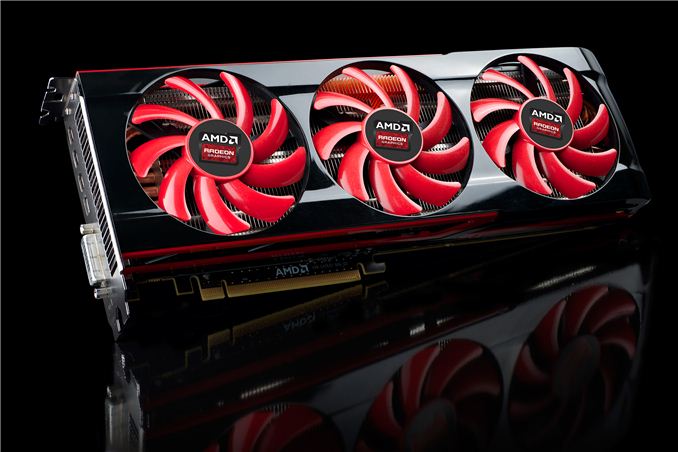AMD Frame Pacing Explored: Catalyst 13.8 Brings Consistency to Crossfire
by Ryan Smith on August 1, 2013 2:00 PM ESTFinal Words
Bringing things to a close, today’s driver release isn’t about any grand revelations for AMD, but rather about AMD following through on their plans and commitments to improve frame time consistency on their products. We’ve seen AMD get their house in order with respect to single-GPU cards earlier this year, and now the same is starting to happen for multi-GPU setups.
To be clear here AMD’s initial situation should never have happened. AMD should have been doing the appropriate competitive analysis from the start, never letting themselves fall behind like this. But we aren’t in the business of berating companies that make an honest effort to improve their products like AMD is doing, so while AMD could have done better in the past they are finally making the right moves in the present, and it’s the present that’s going to be the most important for AMD’s customers.
So what does AMD’s present look like? Quite frankly, it looks a lot better than it did yesterday. AMD set out to greatly improve on their frame pacing situation on their Crossfire setups and they have delivered just that. With just one driver revision we have seen the Radeon HD 7990’s frame pacing go from laughable to acceptable; delta percentages of over 100% have been reduced to 20% or lower in 5 of the 6 games we’ve tested. For those sensitive to micro-stutter and other matters of consistency the difference is at times going to be staggering. At the most basic level, AMD has achieved their objectives.
With that said, there’s still room for improvement, and this goes for both functionality and further improvements in frame consistency. AMD’s triage-like approach means that D3D9, OpenGL, and most importantly Eyefinity are still not capable of using frame metering. These will be covered in future phases of AMD’s rollout of their frame pacing technology, and they can’t come soon enough, but for the time being these are limitations that need to be kept in mind.

Similarly while AMD’s frame pacing has improved to the point where we find it acceptable, 20% deltas are still generally twice that of NVIDIA’s GeForce GTX 690, never mind the extreme consistency single-GPU setups offer. We never realistically expected AMD to match NVIDIA’s frame interval consistency overnight, but in time it would be nice to see them get close, and for both parties to further improve beyond that.
Moving on, while today’s driver release is primarily one part of AMD’s longer term plan to deal with frame interval consistency, AMD is trying hard to also use this moment as something of a second launch for the Radeon HD 7990. With the 7990 launching in April it had the poor timing of arriving shortly after the multi-GPU frame pacing issue came to a head, which is something that has hobbled the card since its launch. In terms of absolute performance (average frame rates) things have changed very little since the launch of the 7990 so we’re not going to get into the matter of performance.
What has changed since then for the 7990 is first and foremost its frame pacing improvements as we’ve seen today. To be very clear here the GTX 690 is still the better card for those users heavily concerned about consistency, but AMD’s improvements have brought the 7990 to the point where we find its frame consistency generally acceptable. This isn’t a rousing recommendation nor is it meant to be, but it’s a reflection of the fact that AMD has brought their consistency to the point where pairing up multiple Tahiti GPUs as is done in the 7990 is no longer fraught with the frame pacing problems it once was. For most users I believe we’re to the point where the consistency differences are greater on paper than they are on the eyes, but of course that is going to depend on the visual acuity of the user.

Moving on, the other thing that has changed for AMD is pricing and competitive positioning. Officially AMD hasn’t cut the price on the 7990, but the fact that XFX is now offering a reference 7990 for $799 after rebate is not a coincidence. With AMD’s Level Up with Never Settle Reloaded promotion still running, AMD is making a clear play for the value segment right now. I don’t believe it’s where AMD would like to be, but there’s no arguing that it’s effective. For users who have a reasonable level of faith in Crossfire scaling and are satisfied with AMD’s frame pacing improvements, a $799 7990 is a very good deal at the moment.
With that in mind, we do want to reiterate that our editorial position here on AFR setups isn’t changing. We still favor strong single-GPU setups over weaker multi-GPU setups, but this is a matter of valuing the lack of AFR profile requirements, coupled with the tendency for newly launched games to have immature AFR profiling, and of course the general consistency issues we’ve covered today. AFR is still the only way to further improve performance once the single-GPU route has been exhausted, and in AMD’s case it’s the only way to exceed the performance of a 7970 GHz Edition, so it does have its place.
Ultimately we have to give AMD the kudos they deserve. They have come forward about their issues, set out a plan to fix them, and have begun delivering on those plans. There’s still room for further improvement within AMD’s drivers, so AMD’s job is far from done, but today they have taken the first step needed to settle the frame pacing problems that have been dogging their products.










102 Comments
View All Comments
boot318 - Thursday, August 1, 2013 - link
I've read a couple people got "black screened" when they did this update on one GPU. I'm not saying that will happen, but you better prepare for it if you do.Bob Todd - Thursday, August 1, 2013 - link
I may have missed this when I skimmed through the results, but have you heard anything about rough estimates from AMD about a frame pacing release supporting Eyefinity (e.g. Q4, H1 2014, etc.)? I know it's still a tiny percentage of users, but there are relatively cheap 1080p IPS panels now so building a nice looking 5760x1080 setup is pretty affordable these days. After playing games this way, it's something I wish I had done earlier, and I'm eager to see a frame pacing driver supporting this setup.Ryan Smith - Thursday, August 1, 2013 - link
Sorry, AMD didn't give us an ETA on that one. Let me see if I can still get one out of them.DanNeely - Thursday, August 1, 2013 - link
HardOCP says DX9 and Eyefinity support should be available in a driver update later this month.http://www.hardocp.com/article/2013/08/01/amd_cata...
DeviousOrange - Thursday, August 1, 2013 - link
I am hoping this will also improve Dual Graphics, will give it a test over the weekend.Homeles - Thursday, August 1, 2013 - link
Well I'll be damned. They did it. Not quite as good as Nvidia, but at this point, the difference isn't really one worth mentioning.xdrol - Thursday, August 1, 2013 - link
The link is bad for the driver, please remove "-auth" from the URL.chizow - Thursday, August 1, 2013 - link
Like watching a baby crawl. Good first step for AMD, but still a long way to go.AMD and their fans can thank the press (mainly TechReport and HardOCP, sorry Derek, you guys were way late to the party and still not fully onboard with FCAT measurements) and Nvidia fans for making such a big stink of this. Lord knows AMD and their fans were too busy looking the other way to address it, anyways.
Hopefully AMD and their fans take something away from this: if you want to improve your product, don't try to sweep it under the rug, address it, own it, and demand a fix for it.
chizow - Thursday, August 1, 2013 - link
Sorry my above post should reference the author Ryan, not Derek (was thinking of your predecessor), when referring to AT not being at the forefront of this runtframe/microstutter issue.Also, I feel the accolades given to TechReport, while not completely undeserving, should also be given to PCPer's Ryan Shrout and some of the German publications like PCGamesHardware. While TechReport did start the ball rolling with some new ways to measure frame latency/microstutter, Ryan Shrout really harped on the runtframe issue until Nvidia worked with him in unveiling FCAT. Also, the German sites have been hammering AMD for years about their much worst microstuttering in CF, largely ignored by the NA press/blogs. And finally Kyle at HardOCP has said for years SLI felt smoother than CF with some Pepsi challenge type user testing, but not so much hard evidence as presented here as well as other sites.
Finally Ryan, are these new metrics you've done an excellent job of formulating going to make it into future benchmarks? Or are you going to just assume the issue has been fixed going forward? I would love to take AMD's word on it but as we've seen from both vendors in the past, driver regression is commonplace unless constantly revisited by users, reviewers, and the vendors alike.
Ryan Smith - Friday, August 2, 2013 - link
"Finally Ryan, are these new metrics you've done an excellent job of formulating going to make it into future benchmarks?"They'll be in future articles in a limited form, similar to how we handled the GTX 780 launch. It takes a lot of additional work to put this data together, which isn't always time we have available. Especially if it becomes doing hours of extra work to collect data just to say "yep, still no stuttering."